Charles E W Bean, Diaries, AWM38 3DRL 606/271/1 - 1917 - 1938 - Part 9
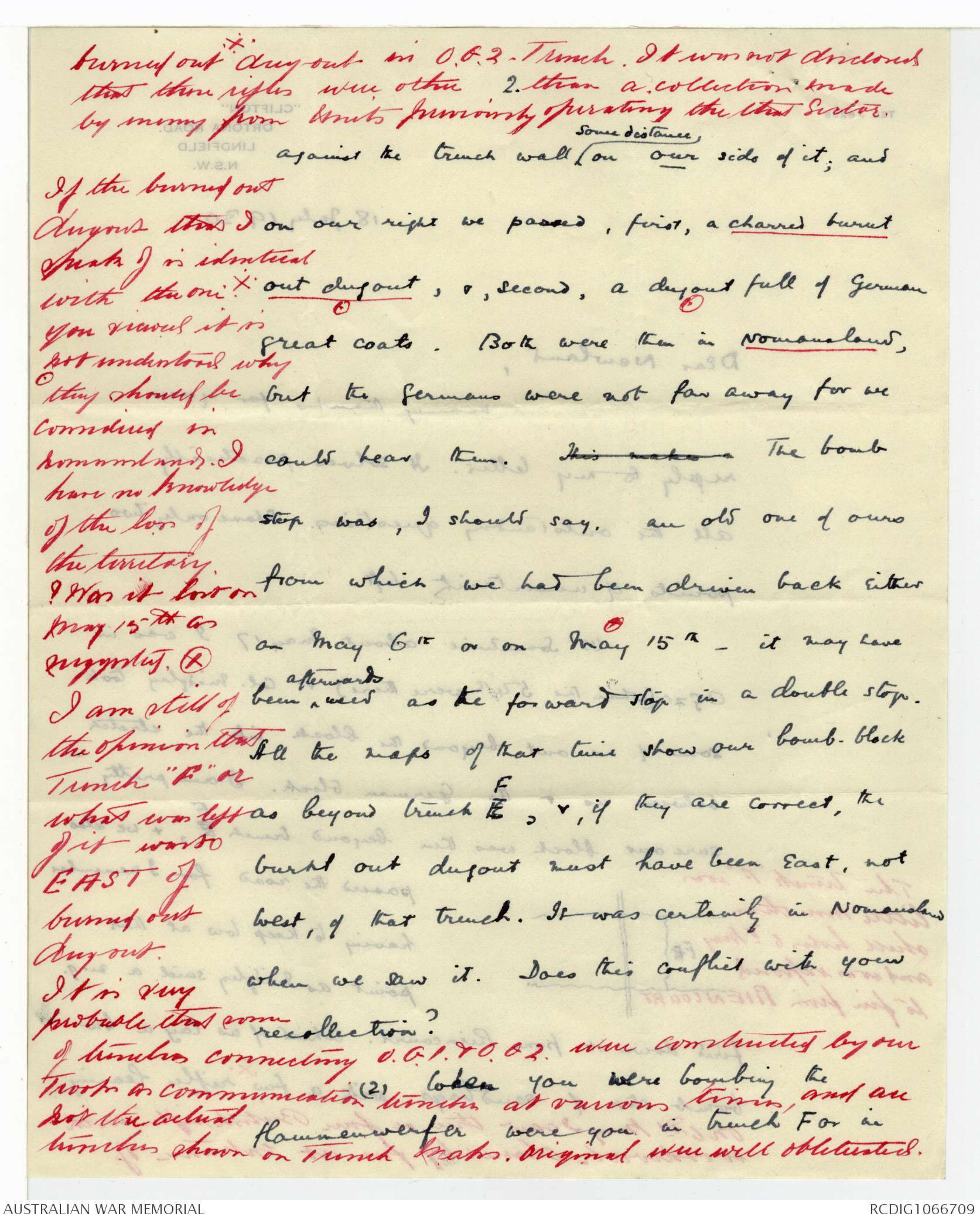
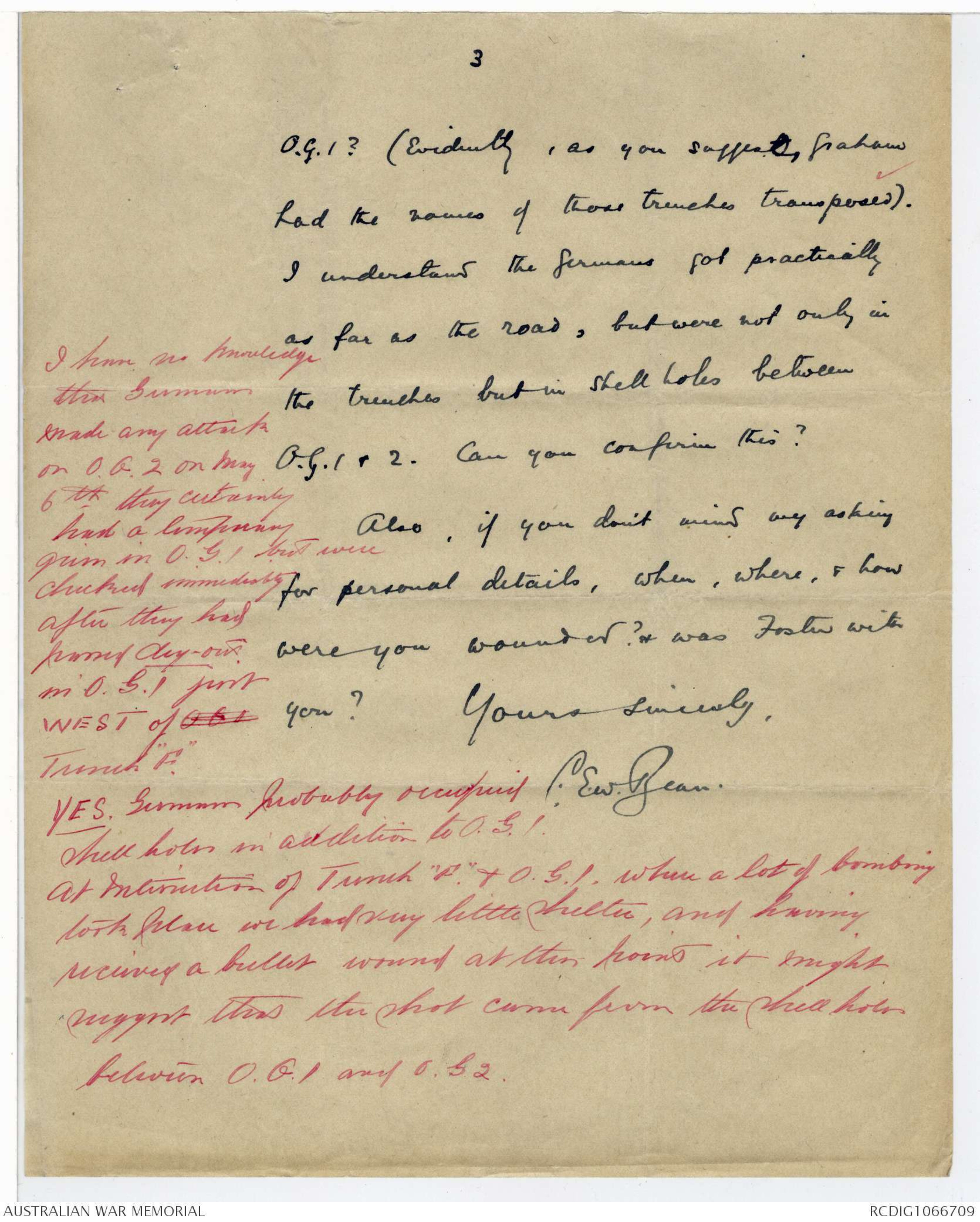
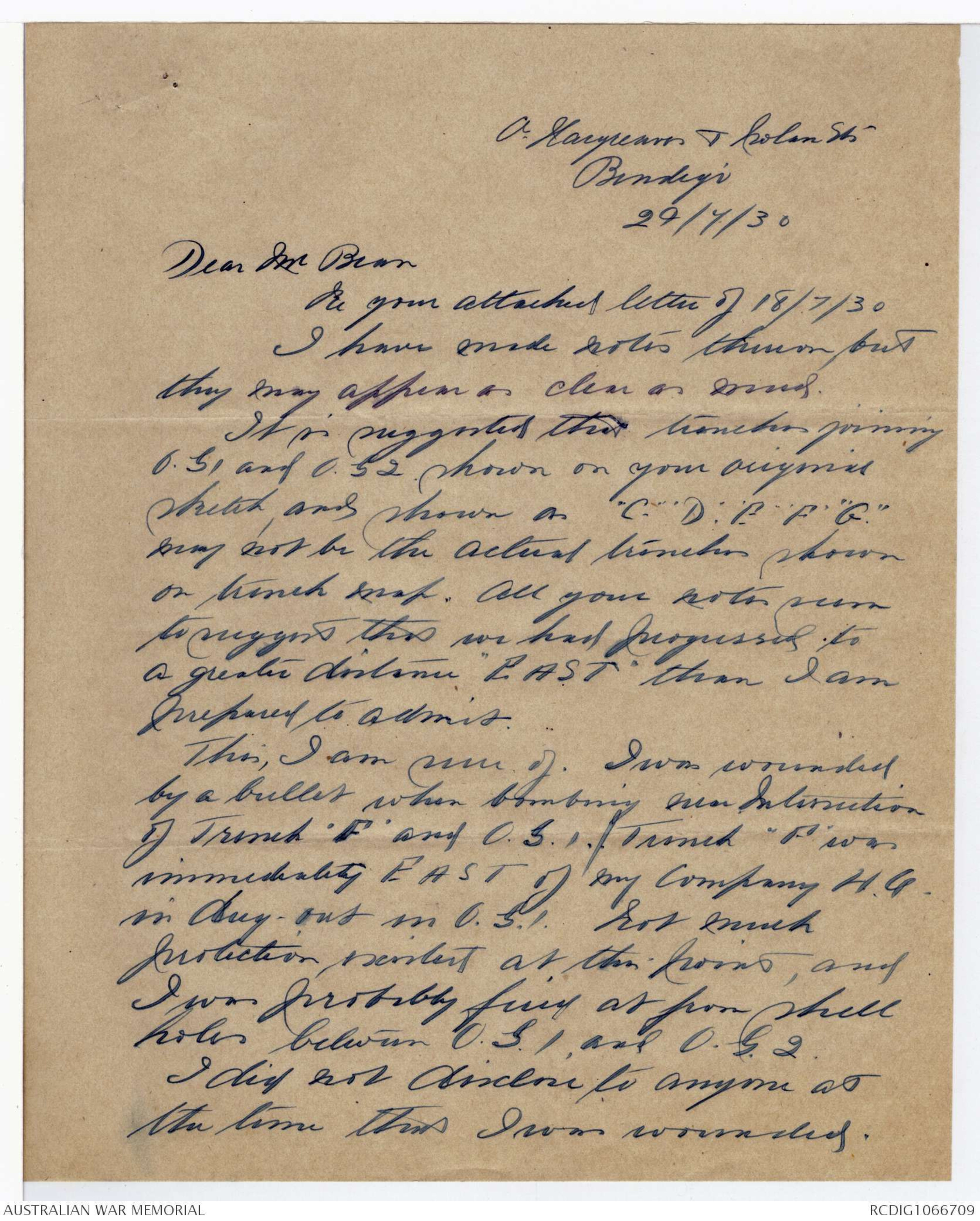

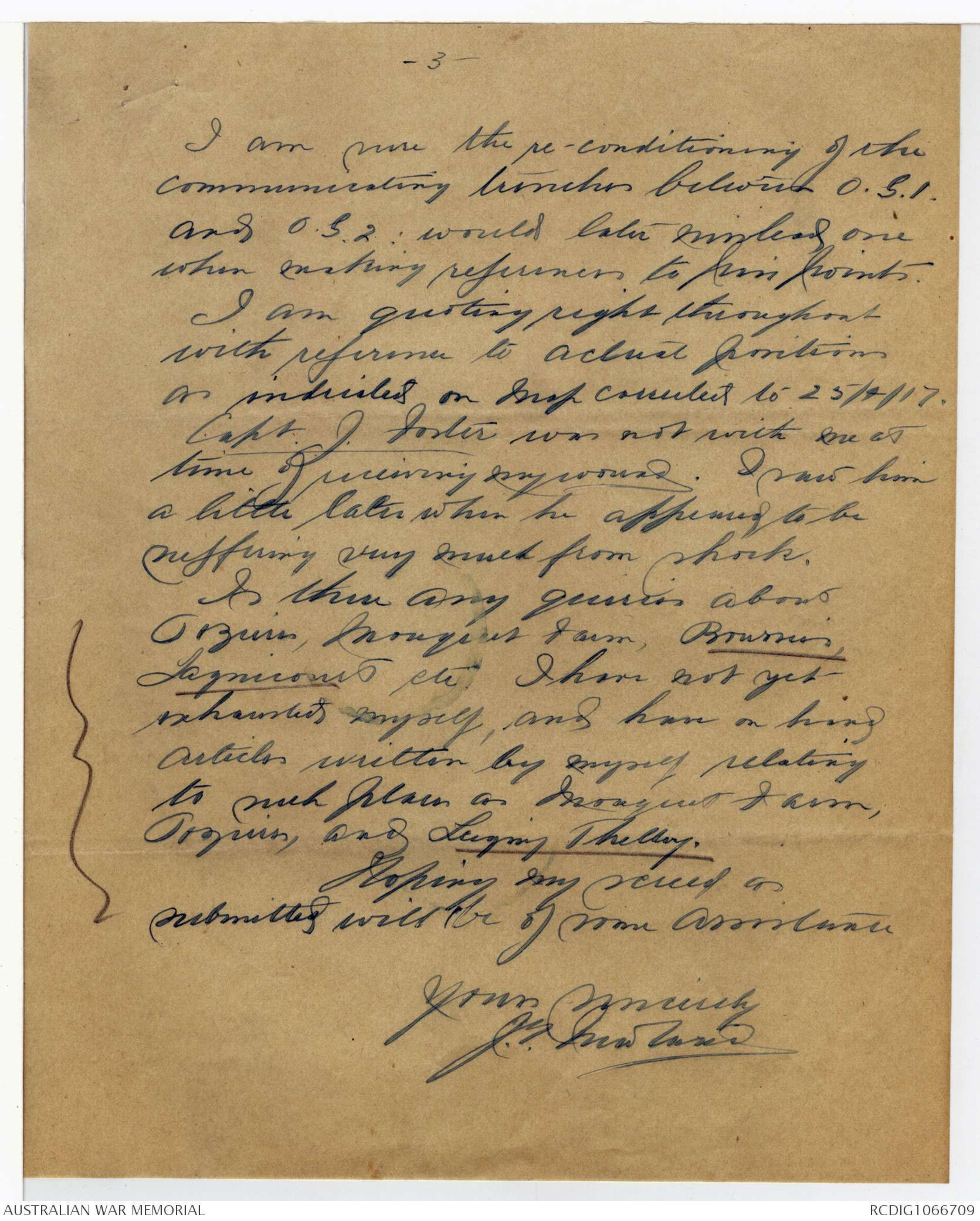
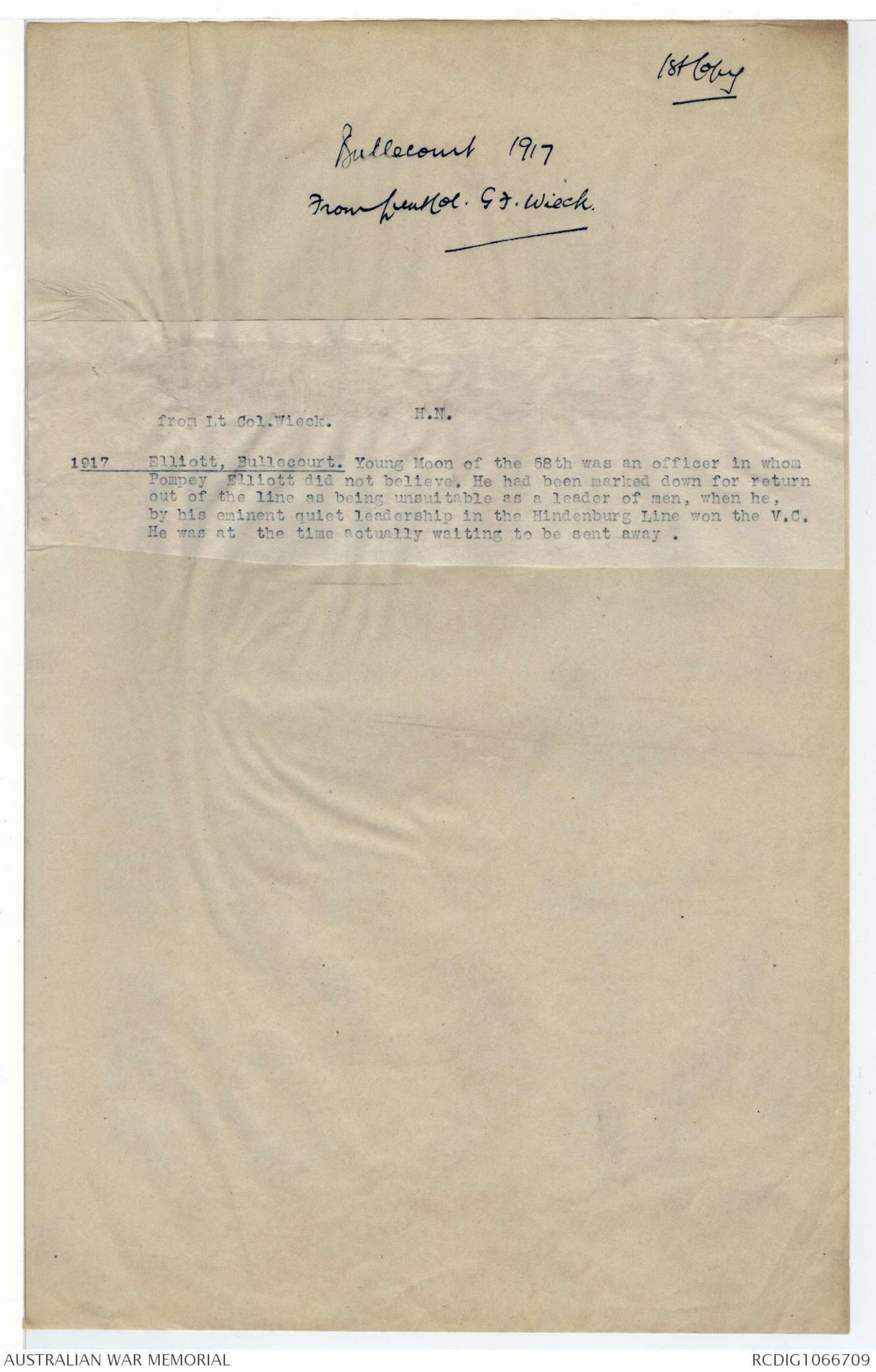
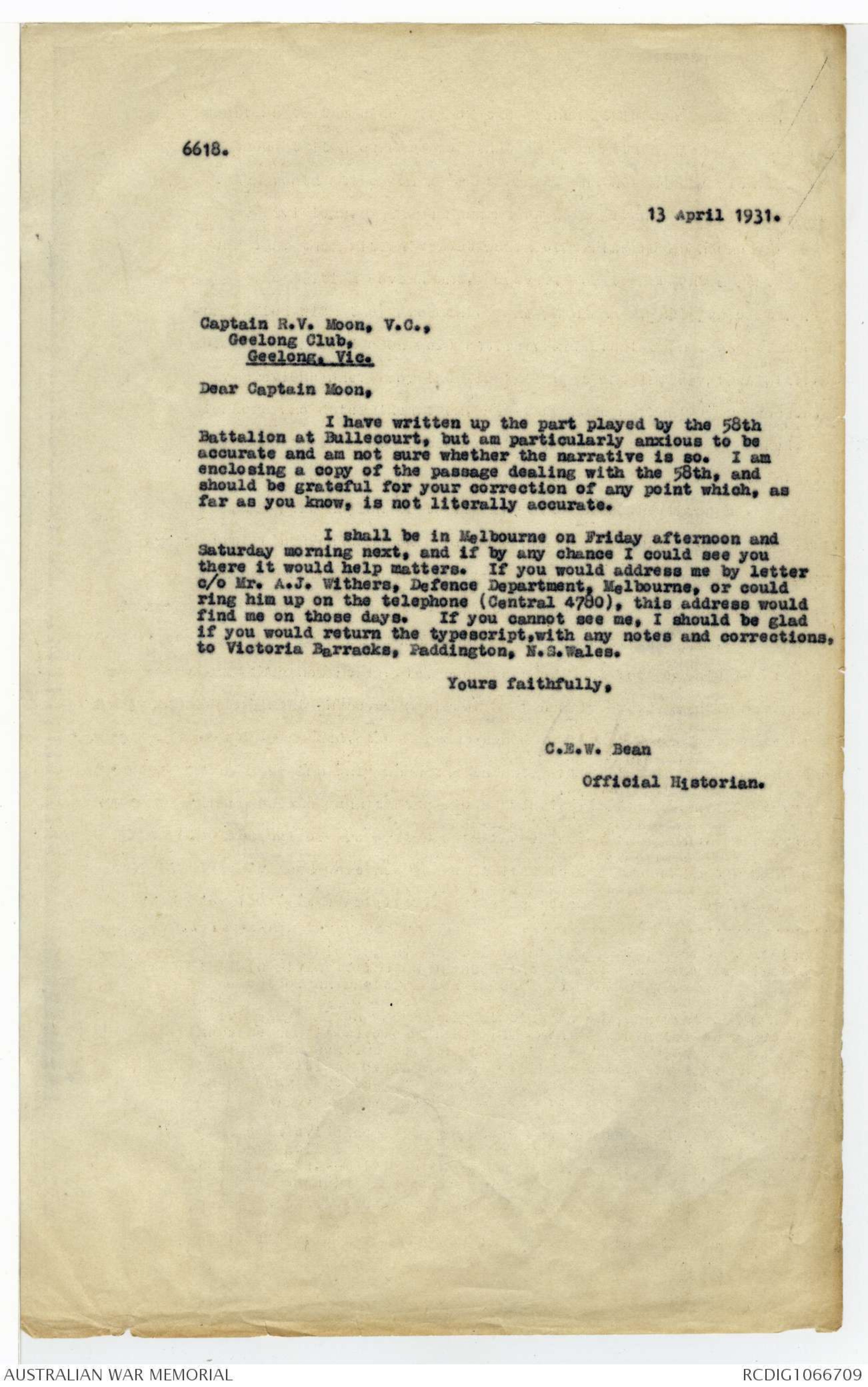
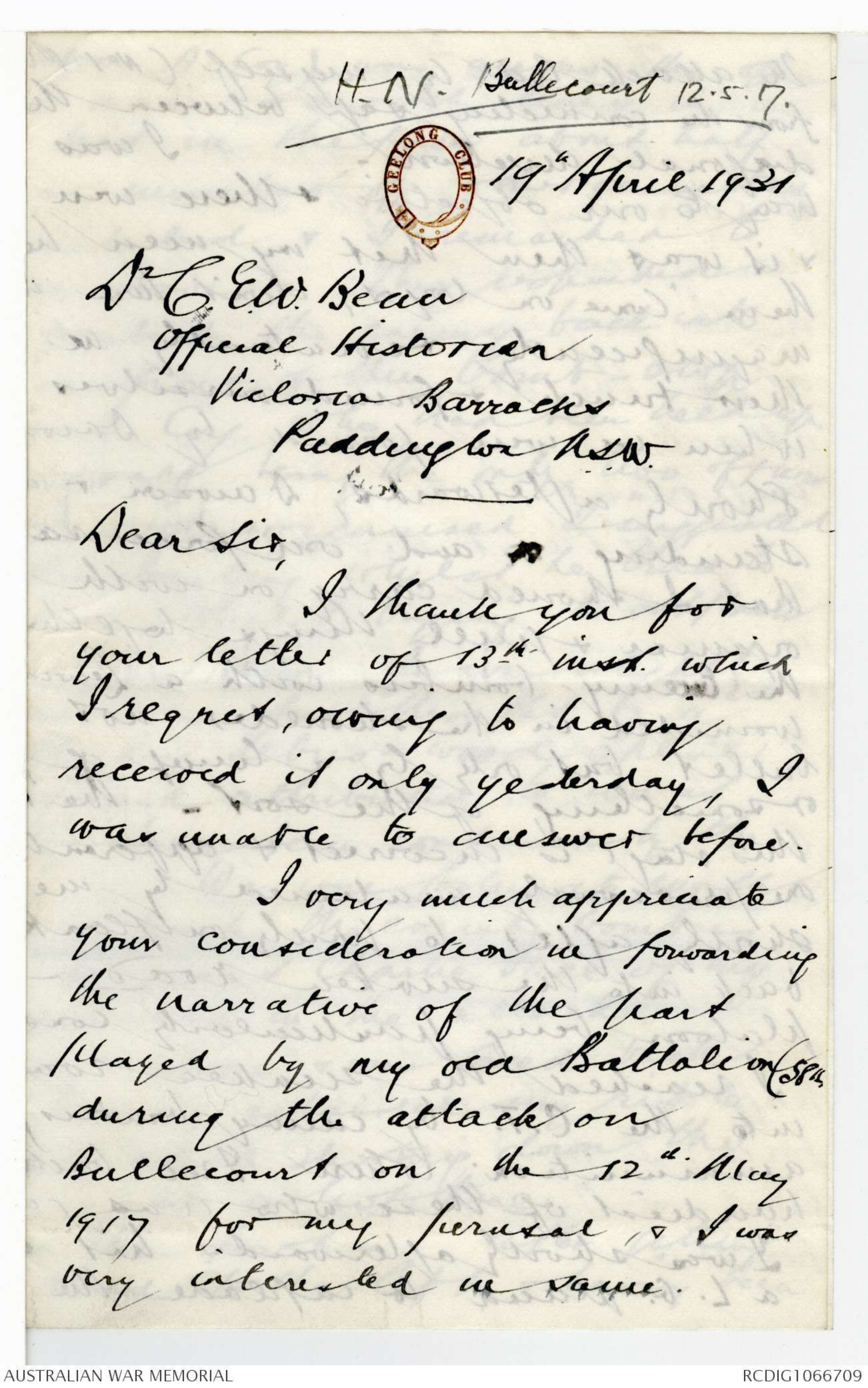
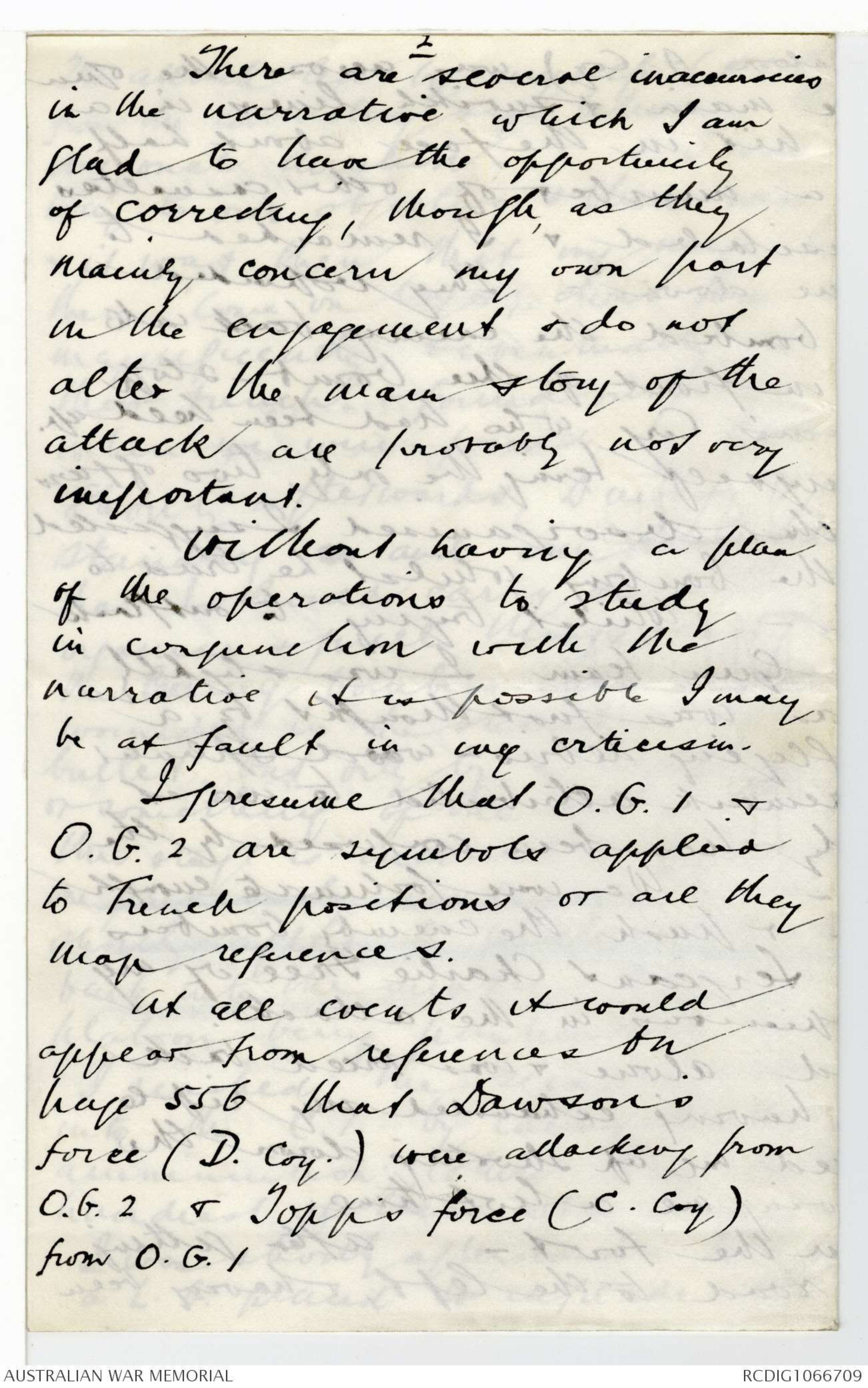
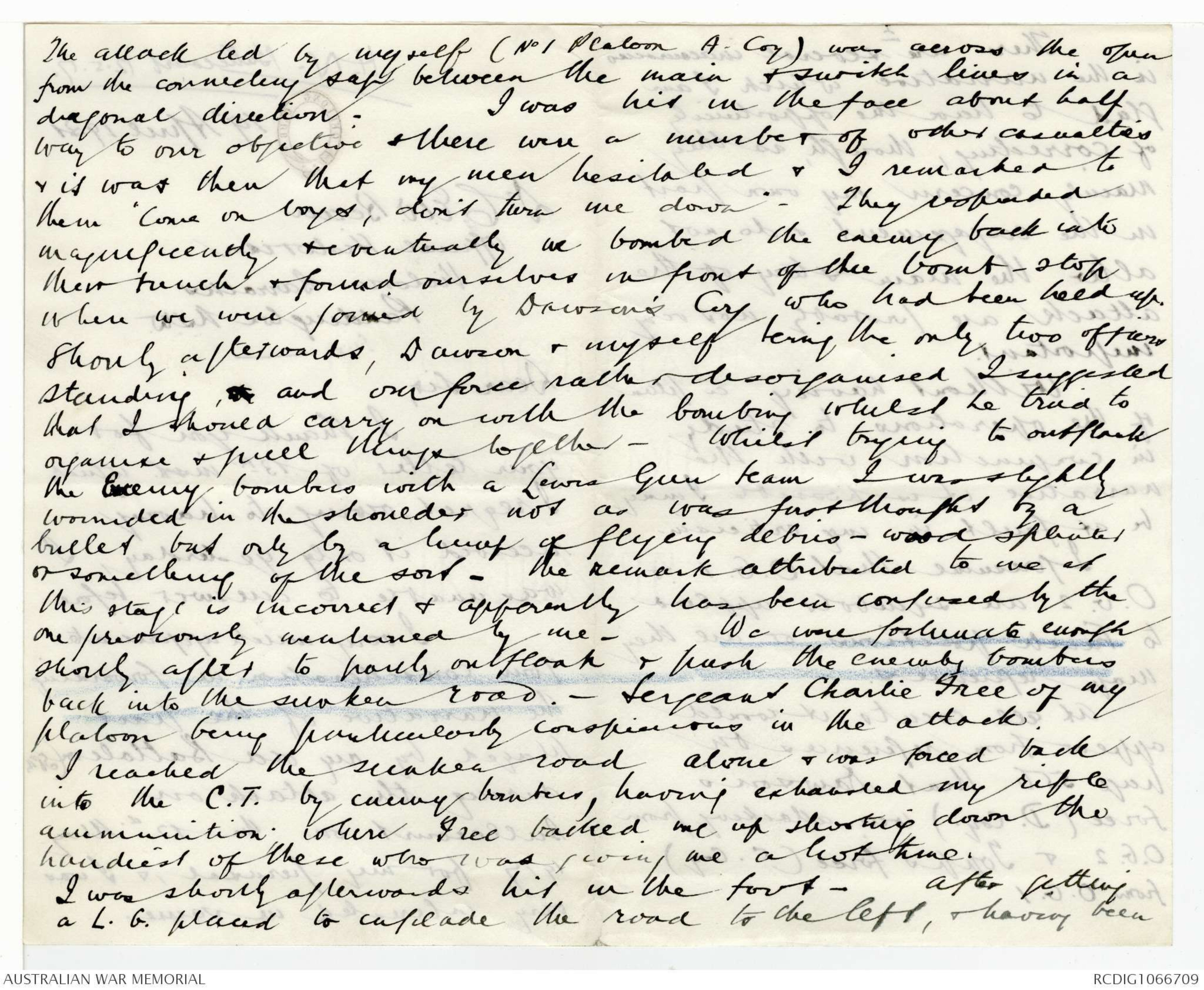
[*※
burned out dug-out in O.G.2. Trench. It was not disclosed
that those rifles were other than a collection made
by enemy from Units previously operating the that Sector.*]
2.
against the trench wall ^some distance on our side of it; and
on our right we passed, first, a charred burnt
out dugout⊙, &, second, a dugout⊙ full of German
great coats. Both were then in Nomansland,
but the Germans were not far away for we
could hear them. This makes The bomb
stop was, I should say, an old one of ours
from which we had been driven back either
on May 6th or on MayⓍ 15th - it may have
been ^afterwards used as the forward stop in a double stop.
All the maps of that time show our bomb. block
as beyond trench E F, &, if they are correct, the
burnt out dugout must have been East, not
West, of that trench. It was certainly in Nomansland
when we saw it. Does this conflict with your
recollection?
(2) When you were bombing the
flammenwerfer were you in trench F or in
[*If the burned out
dugout this I
speak of is identical
with the one ※
you viewed it is
not understood why
⊙they should be
considered in
Nomansland. I
have no knowledge
of the loss of
the territory.
? Was it lost on
May 15th as
suggested. Ⓧ
I am still of
the opinion that
Trench "F" or
what was left
of it was to
EAST of
burned out
dug-out.
It is very
probable that some
of trenches connecting O.G.1. & O.G2. were constructed by our
Troops as communication trenches at various times, and are
not the actual
trenches shown on Trench Maps. Original were well obliterated.*]
3
O.G.1? (Evidently, as you suggest Graham
had the names of those trenches transposed).
I understand the Germans got practically
as far as the road, but were not only in
the trenches but in shell holes between
O.G. 1 & 2. Can you confirm this?
Also, if you don't mind my asking
for personal details, when, where, & how
were you wounded? & was Foster with
you?
Yours Sincerely,
C.E.W. Bean.
[*I have no knowledge
that Germans
made any attack
on O.G.2 on May
6th they certainly
had a temporary
gain in O.G.1 but were
checked immediately
after they had
found dug-out
in O.G.1 just
WEST of O.G.1
Trench "F".
YES. Germans probably occupied
shell holes in addition to O.G.1.
At Intersection of Trench "F" & O.G.1. where a lot of bombing
took place we had very little shelter, and having
received a bullet wound at this point it might
suggest that the shot came from the shell holes
between O.G.1 and O.G2.*]
Cr Hargreaves & Nolan Sts
Bendigo
24/7/30
Dear Mr Bean
Re your attached letter of 18/7/30
I have made notes thereon but
they may appear as clear as mud.
It is suggested that trenches joining
O.G1 and O.G2 shown on your original
sketch, and shown as "C." "D". "E" "F" "G."
may not be the actual trenches shown
on trench map. All your notes seem
to suggest that we had progressed to
a greater distance "EAST" than I am
prepared to admit.
This, I am sure of. I was wounded
by a bullet when bombing near Intersection
of Trench "F" and O.G.1. / Trench "F" was
immediately EAST of my Company H.Q.
in dug-out in O.G.1. Not much
protection existed at this point, and
I was probably fired at from shell
holes between O.G.1, and O.G.2.
I did not disclose to anyone at
the time that I was wounded.
-2-
I probably considered at the time
this might have a bad moral effect.
My left arm was rendered useless
and I was bleeding freely from a
wound in left breast.
I left O.G1. by shell pit to
rear of my Coy. H.Q. I took shelter
in a shell hole, & was unsuccessful
in adjusting my field dressing to
wound. I had to tear the field
dressing open with my teeth. I
was afraid of fainting from loss of
blood. I struggled from this
position due WEST to Road
passing NORTH - SOUTH through
U 29 Central (Ref. Map ECOUST-ST-MEIN
1/10,000) I did not cross
any road after I was wounded
near Trench "F" before reaching the
road U29 Central. This should
definitely fix position of Trench we
have designated Trench "F" and
my Coy. H. Qrs. The burned out
dug-out of which I speak was
in O.G.2. near trench "F".
-3-
I am sure the re-conditioning of the
communicating trenches between O.G.1.
and O.G.2. would later mislead one
when making references to fix points.
I am quoting right throughout
with reference to actual positions
as indicated on map corrected to 25/4/17.
Capt. J. Foster was not with me at
time of receiving my wound. I saw him
a little later when he appeared to be
suffering very much from shock.
Is there any queries about
Pozieres, Mouquet Farm, Boursies
Lagnicourt etc. I have not yet
exhausted myself, and have on hand
articles written by myself relating
to such places as Mouquet Farm,
Pozieres, and Ligny Thilloy.
Hoping my screed as
submitted will be of some assistance.
Yours sincerely
J.M. Newland
[*1st Copy
Bullecourt 1917
From Lieut Col. GF. Wieck.*]
H.N.
From Lt Col.Wieck.
1917 Elliott, Bullecourt. Young Moon of the 58th was an officer in whom
Pompey Elliott did not believe. He had been marked down for return
out of the line as being unsuitable as a leader of men, when he,
by his eminent quiet leadership in the Hindenburg Line won the V.C.
He was at the time actually waiting to be sent away.
6618.
13 April 1931.
Captain R.V. Moon, V.C.,
Geelong Club,
Geelong, Vic.
Dear Captain Moon,
I have written up the part played by the 58th
Battalion at Bullecourt, but am particularly anxious to be
accurate and am not sure whether the narrative is so. I am
enclosing a copy of the passage dealing with the 58th, and
should be grateful for your correction of any point which, as
far as you know, is not literally accurate.
I shall be in Melbourne on Friday afternoon and
Saturday morning next, and if by any chance I could see you
there it would help matters. If you would address me by letter
c/o Mr. A.J. Withers, Defence Department, Melbourne, or could
ring him up on the telephone (Central 4780), this address would
find me on those days. If you cannot see me, I should be glad
if you would return the typescript, with any notes and corrections,
to Victoria Barracks, Paddington, N.S.Wales.
Yours faithfully,
C.E.W. Bean
Official Historian.
[*H.N. Bullecourt 12.5.17.*]
GEELONG CLUB
19th April 1931
Dr C.E.W. Bean
Official Historian
Victoria Barracks
Paddington N.S.W.
Dear Sir,
I thank you for
your letter of 13th inst. which
I regret, owing to having
received it only yesterday, I
was unable to answer before.
I very much appreciate
your consideration in forwarding
the narrative of the part
played by my old Battalion (58th
during the attack on
Bullecourt on the 12th May
1917 for my perusal, & I was
very interested in same.
2
There are several inaccuracies
in the narrative which I am
glad to have the opportunity
of correcting, though, as they
mainly concern my own part
in the engagement & do not
alter the main story of the
attack are probably not very
important.
Without having a plan
of the operations to study
in conjunction with the
narrative it is possible I may
be at fault in my criticism.
I presume that O.G.1 &
O.G.2 are symbols applied
to Trench positions or are they
map references.
At all events it would
appear from references on
page 556 that Dawson's
force (D. Coy) were attacking from
O.G.2 & Topp's force (C. Coy)
from O.G.1
The attack led by myself (No 1 Platoon A. Coy) was across the open
from the connecting sap between the main & switch lines in a
diagonal direction. I was hit in the face about half
way to our objective & there were a number of other casualties
& it was then that my men hesitated & I remarked to
them "Come on boys, don't turn me down" - They responded
magnificently & eventually we bombed the enemy back into
their trench & found ourselves in front of the bomb - stop
where we were joined by Dawson's Coy who had been held up.
Shortly afterwards, Dawson & myself being the only two officers
standing, xx and our force rather disorganised I suggested
that I should carry on with the bombing whilst he tried to
organise & pull things together - Whilst trying to outflank
the Enemy bombers with a Lewis Gun team I was slightly
wounded in the shoulder not as was first thought by a
bullet but only by a lump of flying debris - wood splinter
or something of the sort - the remark attributed to me at
this stage is incorrect & apparently has been confused by the
one previously mentioned by me - We were fortunate enough
shortly after to partly outflank & push the enemy bombers
back into the sunken road. - Sergeant Charlie Free of my
platoon being particularly conspicuous in the attack.
I reached the sunken road alone & was forced back
into the C.T. by enemy bombers, having exhausted my rifle
ammunition when Free backed me up shooting down the
handiest of these who was giving me a hot time.
I was shortly afterwards hit in the foot - after getting
a L. G. placed to enfilade the road to the left, & having been
 Arlene Baade
Arlene BaadeThis transcription item is now locked to you for editing. To release the lock either Save your changes or Cancel.
This lock will be automatically released after 60 minutes of inactivity.